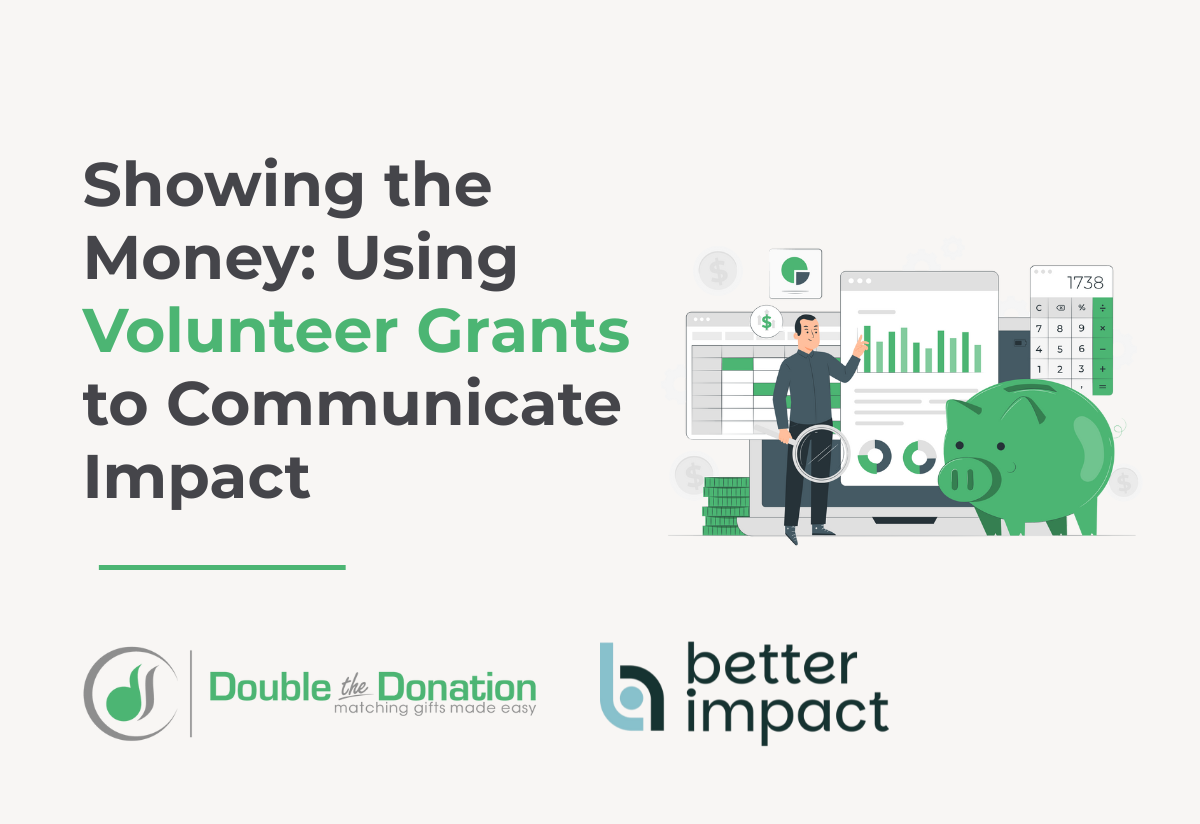Understanding Volunteer Grants and VTO: What to Know
In the realm of volunteer management, programs like volunteer grants and Volunteer Time Off (VTO) are becoming increasingly significant. These...
6 min read
![]() Double the Donation Team
Nov 27, 2025 9:00:02 AM
Double the Donation Team
Nov 27, 2025 9:00:02 AM

Volunteers are often the unsung backbone of nonprofit operations, doing essential work behind the scenes. But how do you bring that value to the forefront? That’s where corporate incentives, such as volunteer grants, come in. By pairing volunteer hours with corporate giving programs, you can convert time into dollars and communicate that impact in financial terms.
In this post, we’ll walk through how to measure volunteer contributions, use volunteer grants to amplify them, and share that story meaningfully with your board and leadership. This encompasses:
Volunteering is often undervalued because it doesn’t translate immediately into cash. In truth, every hour given by a dedicated volunteer has economic value. When you combine that with volunteer grants, you unlock both funding and a clearer narrative about the role volunteers play in advancing your mission.
Below is your roadmap for transforming volunteer contributions into strategic fundraising and impactful storytelling. Let’s dig in!
Many nonprofits struggle to measure the impact of their volunteers for several common reasons. These include:
Because of these gaps, volunteer contributions often remain invisible in financial reports or strategic planning, even if they are vital to program delivery. To break through that barrier, you need tools (such as a volunteer database and volunteer tracking systems) and a method to translate hours into dollars—along with the added leverage of volunteer grants to reinforce that message.
A volunteer grant is a donation made by a company to a nonprofit organization based on the volunteer hours its employees dedicate. Also known as “Dollars for Doers” or “time-matching programs,” these dedicated grants encourage employee community engagement and volunteerism.
Here’s why they matter:
According to available data from Double the Donation, approximately 40% of Fortune 500 companies offer volunteer grant programs, with many of these offering between $10 and $25 per hour for volunteering. That’s additional funding on top of the baseline value that your volunteer hours are worth!
Before you can demonstrate to leadership how volunteer grants enhance your impact, you first need a credible method to convert time into dollars. Here’s what we recommend:
Each year, Independent Sector publishes an estimate for the value of a volunteer hour. For 2024, that figure is $34.79 per hour, which serves as a widely accepted benchmark across the nonprofit sector.
If your state has its own adjustment, use that number if you can get it.
Here’s an example: If your volunteers give 1,000 hours in a year, at $34.79 per hour, that’s $34,790 in “in-kind labor value.”
If you have volunteers doing very different kinds of work (e.g., skilled counseling, IT, or event setup), break down hours by category and apply different valuation rates (e.g., using Bureau of Labor Statistics wage data plus overhead) before multiplying.
Here’s an example:
This helps guard against overvaluing or undervaluing contributions, and it gives you more credibility when presenting your numbers.
Once you know how much your regular volunteer hours are “worth,” corporate volunteer grants add a whole new layer of value. Let’s take a look at an example:
This dual calculation emphasizes that your volunteers are doing the work, and third parties (corporations) are backing it financially.
Did You Know? Volunteers in the U.S. contributed nearly 5 billion hours annually, amounting to over $167 billion in value, when calculated using sector benchmarks.
Once you can roughly quantify the value of your volunteerism, the next step is to weave that into your storytelling in ways that reflect your mission, outcomes, and organizational priorities. Here are a few tips to consider as you do:
Don’t just report “we logged 5,000 hours.” Show how many hours went to:
Then multiply through your valuation. That way, you can report, for example: “Volunteer engagement in program A contributed $20,000 in labor value, representing X % of that project’s total cost.”
One powerful argument is that volunteer work allows you to “do more with less.” You can show how that volunteer labor freed staff for higher-value tasks, saved you from hiring temporary help, or accelerated program delivery.
Whenever possible, link volunteer hours to results. For example:
Then, show how many volunteer hours contributed to those outcomes and translate that into a dollar value, plus any volunteer grants secured.
If possible, compare metrics year over year: “In 2023 we logged 4,000 hours; in 2024 we logged 5,500 hours (value = $190,000), and we captured $8,000 in volunteer grants, a 60% increase in dollar-equivalent impact.”
Leadership loves to see impactful trends and a positive return on its investment.
To effectively utilize volunteer grants, you need reliable systems in place. A volunteer database and volunteer tracking tools are essential to make sure you’re not leaving money or impact on the table.
A volunteer database (or CRM module) centralizes volunteer profiles, their skills, hours, history, employer information, and more. When you know who your volunteers are and where they work, you can better identify which ones are eligible for volunteer grant programs.
For optimal results, volunteers require a reliable method to track their hours. Whether through a mobile app, web portal, kiosk, or even text logging, the more frictionless the experience, the better the data quality you receive.
Tracking tools help you:
If your organization is already using a robust volunteer management tool, ensure it supports employer fields or integrates with corporate giving modules.
It’s one thing to calculate; it’s another to communicate. Your leadership and donors may undervalue volunteer contributions unless they are presented in a compelling manner. Here are a few best practices:
Frame volunteer grants not as an add-on but as an integral piece of your strategy:
“Volunteers deliver vital hours; volunteer grants convert hours into funding; together they bring more mission reach for less financial cost.”
Use visual aids: bar charts of hours → dollar value → grant funding, or pie charts showing proportions by program, side by side with financials.
Provide executive dashboards or quarterly summaries showing:
Use your volunteer database or workplace giving platform to support compiling those reports if possible.
When you submit budgets for programs, include “volunteer labor value” as a line item. Show how reducing volunteer support or limiting tracking could reduce that value, or conversely, how investing more (in training, systems, etc.) could increase it.
When you submit volunteer grants or share aggregate numbers, publicly acknowledge both volunteers and their employers. Doing so builds goodwill and encourages future participation.
Numbers engage the brain; stories engage the heart. Pair your calculated metrics with one or two volunteer anecdotes: For example, “Jane volunteered 200 hours building reading kits. Her employer gave $2,000 through their volunteer grant program. Together, they enabled us to distribute 1,000 kits to underprivileged children.”
Volunteers bring an immense amount of value to every nonprofit, but that impact often goes unnoticed without the right tools and framing. By leveraging volunteer grants, organizations can translate donated time into measurable financial impact, making it easier to communicate value to leadership, funders, and other stakeholders.
When leadership can see how volunteer time supports program goals and generates additional revenue, they are more likely to invest in growing and sustaining your program. Good luck!
Featured Posts

In the realm of volunteer management, programs like volunteer grants and Volunteer Time Off (VTO) are becoming increasingly significant. These...

We talk a lot about burnout in the nonprofit sector, and burnout is especially common among volunteer engagement professionals. According to a 2017...
.png)
To make your organization’s volunteer program as effective as possible, you need to give volunteers everything they need to succeed. Besides knowing...